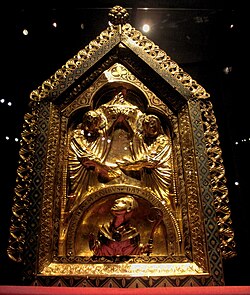Gondulphus of Tongeren
| Saint Gondulph | |
|---|---|

Saint Gondulph looking up from his grave. The Latin inscription reads: "Hec nostris manibus dat vobis premia Christus (Through our hands Christ gives you this crown)"
(reliquary, Cinquantenaire Museum, Brussels) |
|
| Born | 524 |
| Died | after 614 AD |
| Venerated in |
Roman Catholic Church Eastern Orthodox Church |
| Feast | 17 June |
| Attributes | Often depicted with Monulph, both holding miniature churches |
Gondulph (Latin: Gondulfus, Gundulphus, perhaps also Bethulphus) of Maastricht, sometimes of Tongeren (6th/7th century AD) was a Bishop of Tongeren-Maastricht venerated as a Roman Catholic and Eastern Orthodox saint. Together with Saint Servatius and Saint Monulph, Saint Gondulph is one of the patron saints of the city of Maastricht.
Gondulph's parents were Munderic of Vitre en Perthois (500-532 a.d.) and Arthemia of Perthois (born ca. 525 a.d.). He was married to Palatina de Troyes. The couple had a son named Baudgise D'Aquitaine II, who became Duke of Aquitaine, France. Gondulph was buried in the nave of the church of Saint Servatius in Maastricht, which was built by his predecessor Monulph.
He remains a somewhat enigmatic figure. It has been questioned whether he could be identical with Monulph, but the two saints are usually distinguished.
According to some 11th century sources Gondulph's predecessor Monulph transferred the episcopal see from Tongeren to Maastricht. However, the official title episcopus Tungrorum (bishop of Tongeren) was retained until the 10th century, although the episcopal see had by that time been transferred from Maastricht to Liège.
Monulph must have occupied the See of Tongeren-Maastricht until the end of the 6th, beginning of the 7th century, because a bishop of Maastricht named Betulphus was present at the Council of Paris in 614. Gondulph then could have been inserted between Monulph and Betulphus, at least if Betulphus is not identified with Gondulph. The case is similar to the situation in the Archbishopric of Mainz, where Bertulfus and Crotoldus seem to be identical. Furthermore, the disputed episcopal lists of the 11th and 12th centuries ignore the historically-attested Betulphus and make Gondulph the immediate successor of Monulph. The biographies of Gondulph from the Middle Ages are largely extracts from the Vita Servatii written by the French priest Jocundus and not entirely reliable.
...
Wikipedia
